TL-WA901N V6 User Guide
Chapter 4 Configure the Access Point
This chapter presents how to configure the various features of your access point.
It contains the following sections:
1.Visit http://tplinkap.net, and log in using the password you created.
2.Go to Status. You can view the current status information of the access point.
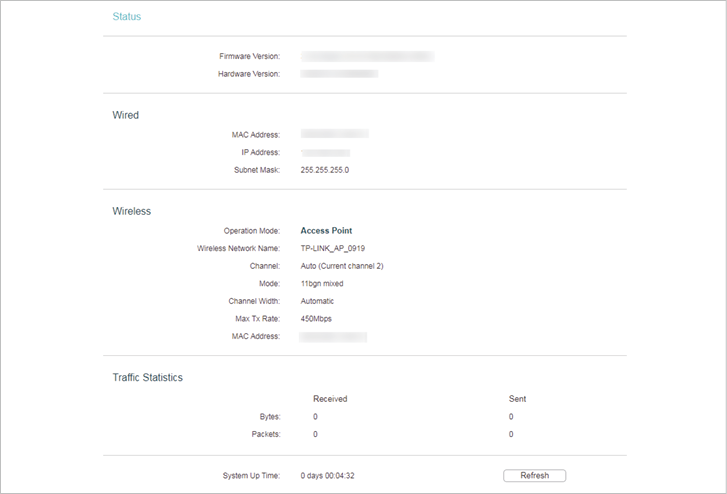
•Firmware Version - The version information of the access point’s firmware.
•Hardware Version - The version information of the access point’s hardware.
•Wired - This field displays the current settings of the LAN, and you can configure them on the Network > LAN page.
•MAC address - The physical address of the access point.
•IP address - The LAN IP address of the access point.
•Subnet Mask - The subnet mask associated with the LAN IP address.
•Wireless - This field displays the basic information or status of the wireless function, and you can configure them on the Wireless > Wireless Settings page.
•Operation Mode - The current wireless working mode in use.
•Wireless Network Name - The SSID of the access point.
•Channel - The current wireless channel in use.
•Mode - The current wireless mode which the access point works on.
•Channel Width - The current wireless channel width in use.
•Max Tx Rate - The highset tranmit rate of the access point.
•MAC Address - The physical address of the access point.
•Traffic Statistics - The access point’s traffic stastics.
•Received (Bytes) - Traffic in bytes received from the ETHERNET port.
•Received (Packets) - Traffic in packets received from the ETHERNET port.
•Sent (Bytes) - Traffic in bytes sent out from the ETHERNET port.
•Sent (Packets) - Traffic in packets sent out from the ETHERNET port.
•System Up Time - The length of the time since the access point was last powered on or reset.
Click Refresh to get the latest status and settings of the access point.
If you want to change the mode of your access point after it has been first configured, you can select the mode you want in Operation Mode.
1.Visit http://tplinkap.net, and log in using the password you created.
2.Go to Operation Mode.
3.Select the mode you want.

1.Visit http://tplinkap.net, and log in using the password you created.
2.Go to Network > LAN.
3.Configure the IP parameters of the LAN and click Save.
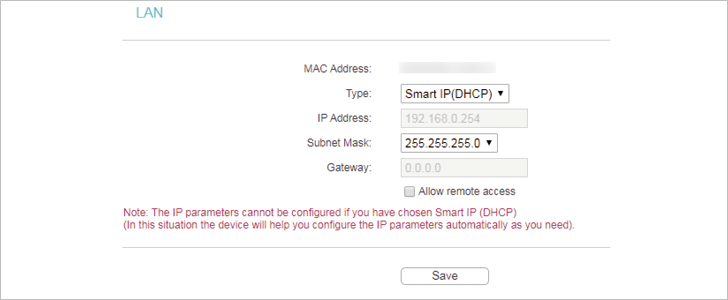
•MAC Address - The physical address of the LAN ports. The value can not be changed.
•Type - Either select Smart IP(DHCP) to get IP address from DHCP server, or Static IP to configure IP address manually.
•IP Address - Enter the IP address in dotted-decimal notation if your select Static IP (factory default - 192.168.0.254).
•Subnet Mask - An address code that determines the size of the network. Normally 255.255.255.0 is used as the subnet mask.
•Gateway - The gateway should be in the same subnet as your IP address.
 Note:
Note:
•If you have changed the IP address, you must use the new IP address to login.
•If you select Smart IP(DHCP), settings of the DHCP server is unchangable.
•If the new IP address you set is not in the same subnet as the old one, the IP Address pool in the DHCP Server will be configured automatically.
3.2. DHCP Settings
1.Visit http://tplinkap.net, and log in using the password you created.
2.Go to Network > DHCP Settings.
3.Specify DHCP server settings and click Save.
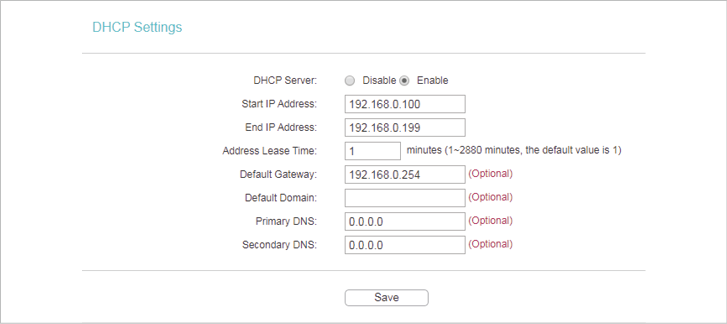
•DHCP Server - Enable or disable the DHCP server. If disabled, you must have another DHCP server within your network or else you must configure the computer manually.
•Start IP Address - Specify an IP address for the DHCP Server to start with when assigning IP addresses. 192.168.0.100 is the default start address.
•End IP Address - Specify an IP address for the DHCP Server to end with when assigning IP addresses. 192.168.0.199 is the default end address.
•Address Lease Time - The Address Lease Time is the amount of time a network user will be allowed to connect to the access point with the current dynamic IP Address. When time is up, the user will be automatically assigned a new dynamic IP address. The range of the time is 1 ~ 2880 minutes. The default value is 1.
•Default Gateway (Optional) - It is suggested to input the IP address of the LAN port of the access point. The default value is 192.168.0.254.
•Default Domain (Optional) - Input the domain name of your network.
•Primary DNS (Optional) - Input the DNS IP address provided by your ISP.
•Secondary DNS (Optional) - Input the IP address of another DNS server if your ISP provides two DNS servers.
 Note:
Note:
•To use the DHCP server function of the access point, you must configure all computers on the LAN as Obtain an IP Address automatically.
•When you choose Smart IP (DHCP) in Network > LAN, settings of the DHCP server is unchangable. You will see the page as below.
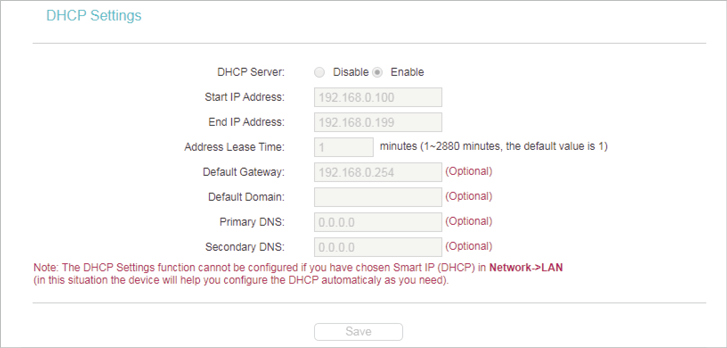
3.3. DHCP Client List
1.Visit http://tplinkap.net, and log in using the password you created.
2.Go to DHCP > DHCP Client List to view the information of the clients connected to the access point.

•Client Name - The name of the DHCP client.
•MAC Address - The MAC address of the DHCP client.
•Assigned IP - The IP address that the access point has allocated to the DHCP client.
•Lease Time - The time of the DHCP client leased. After the dynamic IP address has expired, a new dynamic IP address will be automatically assigned to the user.
You cannot change any of the values on this page. To update this page and show the current attached devices, click Refresh.
4.1. Wireless Settings
1.Visit http://tplinkap.net, and log in using the password you created.
2.Go to Wireless > Wireless Settings.
3.Four operation modes are supported here, including Access Point, Multi-SSID, Client, and Range Extender.
Access Point Mode
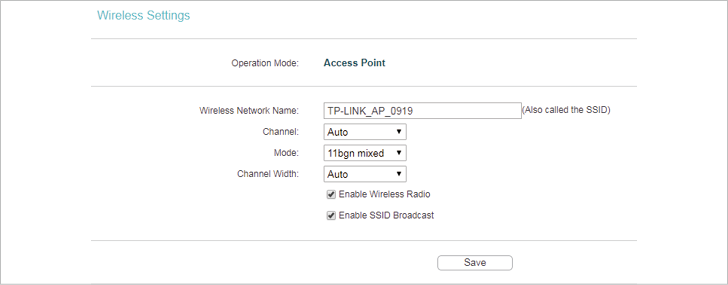
•Wireless Network Name - Identifies your wireless network name. Create a name up to 32 characters and make sure all wireless points in the wireless network with the same SSID. The default SSID is TP-LINK_AP_XXXX (XXXX indicates the last unique four characters of each device’s MAC address). This value is case-sensitive. For example, TEST is NOT the same as test.
•Channel - Determines the operating frequency to be used. It is not necessary to change the wireless channel unless you notice interference problems with another nearby access point.
•Mode - Select the desired wireless mode. The options are:
•11b only - Only 802.11b wireless stations can connect to the device.
•11g only - Only 802.11g wireless stations can connect to the device.
•11n only - Only 802.11n wireless stations can connect to the device.
•11bg mixed - Both 802.11b and 802.11g wireless stations can connect to the device.
•11bgn mixed - All 802.11b, 802.11g and 802.11n wireless stations can connect to the device.
•Channel Width - Determines the channel width to be used. It is unnecessary to change the default value unless required.
•Enable Wireless Radio - Select or deselect this check box to allow or deny wireless stations to access the device.
•Enable SSID Broadcast - Select or deselect this check box to allow or deny the device to broadcast its name (SSID) on the air. If it’s allowed, when wireless clients survey the local area for wireless networks to associate with, they will detect the SSID broadcast by the device.
Multi-SSID Mode
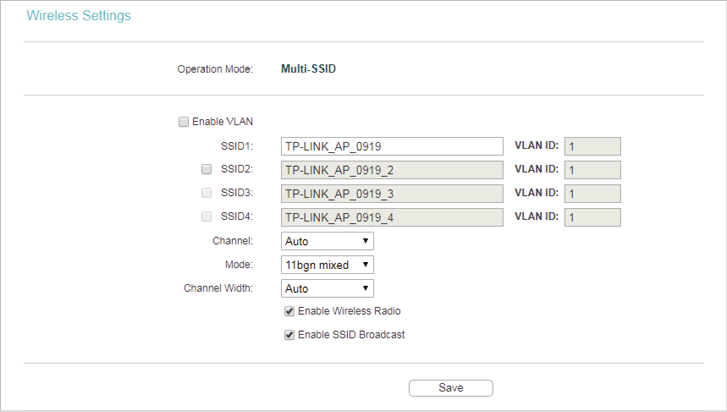
•Enable VLAN - Check this box and then you can change the VLAN ID of each SSID. If you want to configure the Guest and Internal networks on VLAN, the switch you are using must support VLAN. As a prerequisite step, configure a port on the switch for handling VLAN tagged packets as described in the IEEE802.1Q standard, and enable this field.
•SSID (1-4) - Up to four SSIDs for each BSS (Basic Service Set) can be entered in the filed SSID1 ~ SSID4. The name can be up to 32 characters. The same name (SSID) must be assigned to all wireless devices in your network. If Enable VLAN is checked, the wireless stations connecting to SSID of different VLANID can not communicate with each other.
•VLAN ID (1-4) - Provide a number between 1 and 4095 for VLAN. This will cause the device to send packets with VLAN tags. The switch connecting with the device must support VLAN IEEE802.1Q frames. The wireless stations connecting to the SSID of a specified VLAN ID can communicate with the PC connecting to the port with the same VLAN ID on the Switch.
•Channel - Determines the operating frequency to be used. It is not necessary to change the wireless channel unless you notice interference problems with another nearby access point.
•Mode - This field determines the wireless mode which the device works on.
•11b only - Only 802.11b wireless stations can connect to the device.
•11g only - Only 802.11g wireless stations can connect to the device.
•11n only - Only 802.11n wireless stations can connect to the device.
•11bg mixed - Both 802.11b and 802.11g wireless stations can connect to the device.
•11bgn mixed - All 802.11b, 802.11g and 802.11n wireless stations can connect to the device.
•Channel Width - Determines the channel width to be used. It is unnecessary to change the default value unless required.
•Enable Wireless Radio - Select or deselect this check box to allow or deny wireless stations to access the device.
•Enable SSID Broadcast - Select or deselect this check box to allow or deny the device to broadcast its name (SSID) on the air. If it’s allowed, when wireless clients survey the local area for wireless networks to associate with, they will detect the SSID broadcast by the device.
Client Mode
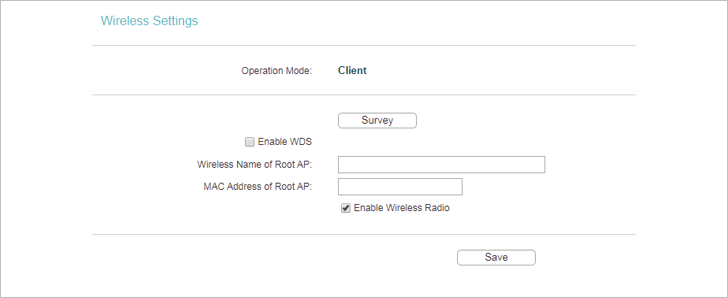
•Enable WDS - The AP client can connect to AP with WDS enabled or disabled. If WDS is enabled, all traffic from wired networks will be forwarded in the format of WDS frames consisting of four address fields. If WDS is disabled, three address frames are used. If your AP supports WDS well, please enable this option.
•Wireless Name of Root AP - Enter the SSID of AP that you want to access or click Survey to find the network you want to connec to.
•MAC Address of Root AP - Enter the MAC address of AP that you want to access.
•Enable Wireless Radio - Select or deselect this check box to enable or disable wireless function.
•Click the Survey button to detect the SSIDs in the local area.
Range Extender Mode
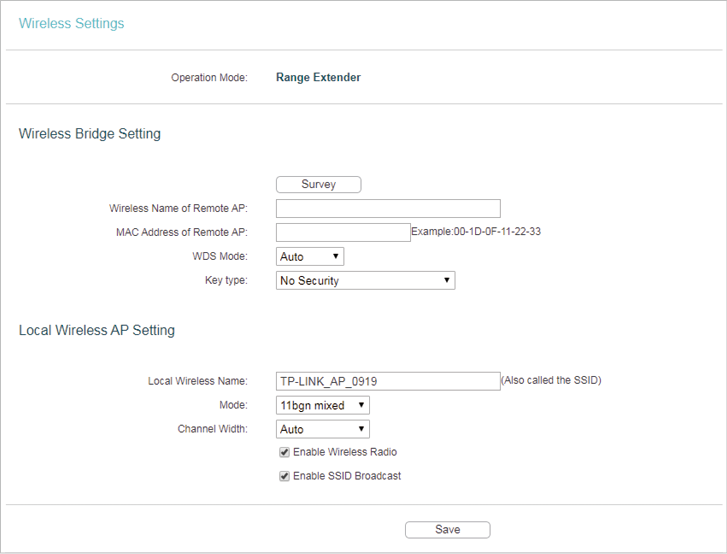
Wireless Bridge Setttings
•Wireless Name of Remote AP - Enter the SSID of AP that you want to access or click Survey to find the network you want to connect to.
•MAC Address of Remote AP - Enter the MAC address of AP that you want to access.Click the Survey button to detect the SSIDs in the local area.
•WDS Mode - This field determines which WDS Mode will be used. It is not necessary to change the WDS Mode unless you notice network communication problems with root AP. If you select Auto, then Router will choose the appropriate WDS Mode automatically.
•Key type - This option should be chosen according to the AP’s security configuration. It is recommended that the security type is the same as your AP’s security type.
•Password - If the Remote AP that your device is going to connect needs password, you need to fill the password in this blank.
Local Wireless AP Setting
•Local Wireless Name - Name for the AP.
•Mode - This field determines the wireless mode which the device works on.
•11b only - Only 802.11b wireless stations can connect to the device.
•11g only - Only 802.11g wireless stations can connect to the device.
•11n only - Only 802.11n wireless stations can connect to the device.
•11bg mixed - Both 802.11b and 802.11g wireless stations can connect to the device.
•11bgn mixed - All 802.11b, 802.11g and 802.11n wireless stations can connect to the device.
•Channel Width - Determines the channel width to be used. It is unnecessary to change the default value unless required.
•Enable Wireless Radio - Select or deselect this check box to allow or deny wireless stations to access the device.
•Enable SSID Broadcast - Select or deselect this check box to allow or deny the device to broadcast its name (SSID) on the air. If it’s allowed, when wireless clients survey the local area for wireless networks to associate with, they will detect the SSID broadcast by the device.
4.2. Wireless Security
1.Visit http://tplinkap.net, and log in using the password you created.
2.Go to Wireless > Wireless Security.
3.Configure the security settings of your wireless network and click Save. The security options are different for different operation mode.
Access Point
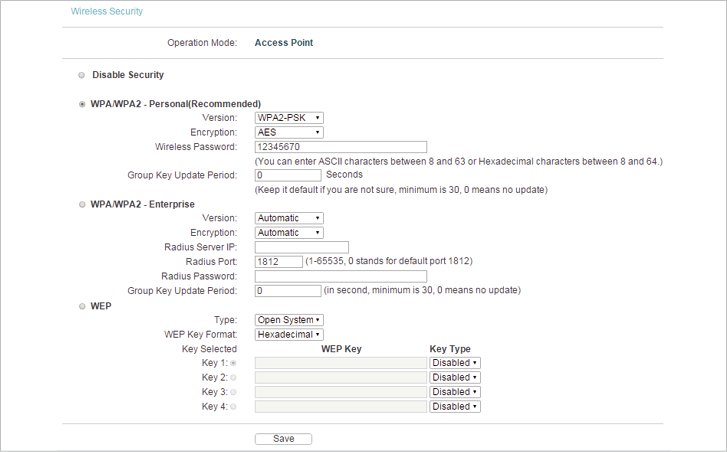
•Disable Security - Check this box radio button to disable wireless security. If disabled, the wireless stations will be able to connect this device without encryption. It is strongly recommended that you choose one of the security types to enable security.
•WPA/WPA2-Personal(Recommended) - Select WPA/WPA2 based on Radius Server.
•Version - You can select one of following versions.
•Automatic (Recommended) - Select WPA-Personal or WPA2-Personal automatically based on the wireless station’s capability and request.
•WPA-PSK - Pre-shared key of WPA.
•WPA2-PSK - Pre-shared key of WPA2.
•Encryption - You can select either Automatic(Recommended), TKIP or AES.
•Wireless password - You can enter ASCII or Hexadecimal characters. For Hexadecimal, the length should be between 8 and 64 characters; for ASCII, the length should be between 8 and 63 characters.
•Group Key Update Period - Specify the group key update interval in seconds. The value can be either 0 or at least 30. Enter 0 to disable the update.
•WPA/WPA2-Enterprise - Select WPA/WPA2 based on Radius Server.
•Version - You can select one of following versions.
•Automatic - Select WPA or WPA2 automatically based on the wireless station’s capability and request.
•WPA - Wi-Fi Protected Access.
•WPA2 - WPA version 2.
•Encryption - You can select either Automatic, TKIP or AES.
•Radius Server IP - Enter the IP address of the Radius Server.
•Radius Port - Enter the port used by radius service.
•Radius password - Enter the password for the Radius Server.
•Group Key Update Period - Specify the group key update interval in seconds. The value can be either 0 or at least 30. Enter 0 to disable the update.
•WEP - Select 802.11 WEP security.
•Type - You can select one of following types.
•Automatic - Select Shared Key or Open System authentication type automatically based on the wireless station’s capability and request.
•Shared Key - Select 802.11 Shared Key authentication type.
•Open System - Select 802.11 Open System authentication.
•WEP Key Format - You can select ASCII or Hexadecimal format. ASCII format stands for any combination of keyboard characters in the specified length. Hexadecimal format stands for any combination of hexadecimal digits (0-9, a-f, A-F) in the specified length.
•WEP Key - Select which of the four keys will be used and enter the matching WEP key information for your network in the selected key radio button. These values must be identical on all wireless stations in your network.
•Key Type - You can select the WEP key length (64-bit, or 128-bit, or 152-bit.) for encryption. “Disabled” means this WEP key entry is invalid.
•For 64-bit encryption - You can enter 10 hexadecimal digits (any combination of 0-9, a-f, A-F, zero key is not permitted) or 5 ASCII characters.
•For 128-bit encryption - You can enter 26 hexadecimal digits (any combination of 0-9, a-f, A-F, zero key is not permitted) or 13 ASCII characters.
•For 152-bit encryption - You can enter 32 hexadecimal digits (any combination of 0-9, a-f, A-F, zero key is not permitted) or 16 ASCII characters.
 Note:
Note:
•If you do not set the key, the wireless security function is still disabled even if you have selected Shared Key as Authentication Type.
Multi-SSID
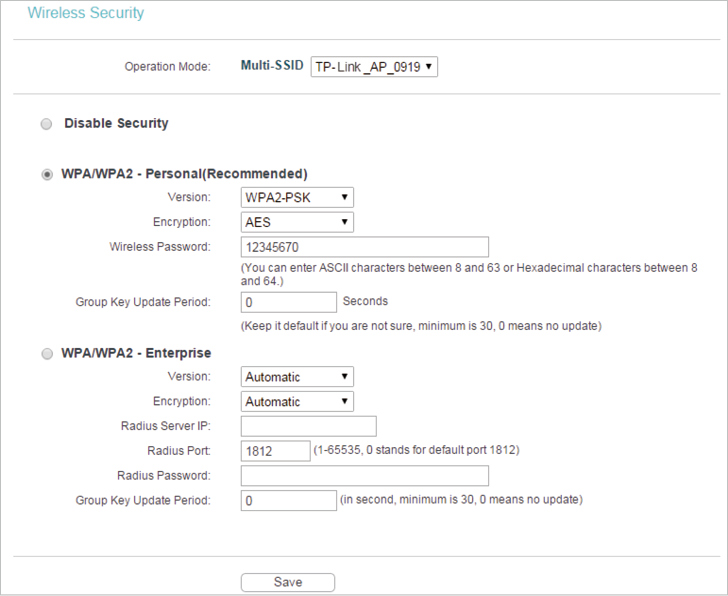
You can choose which SSID to configure wireless security settings for in the blank behind Operation Mode.
•Disable Security - Check this box radio button to disable wireless security. If disabled, the wireless stations will be able to connect this device without encryption. It is strongly recommended that you choose one of the security types to enable security.
•WPA/WPA2-Personal (Recommended) - Select WPA/WPA2 based on Radius Server.
•Version - You can select one of following versions.
•Automatic (Recommended) - Select WPA-Personal or WPA2-Personal automatically based on the wireless station’s capability and request.
•WPA-PSK - Pre-shared key of WPA.
•WPA2-PSK - Pre-shared key of WPA2.
•Encryption - You can select either Automatic(Recommended), TKIP or AES.
•Wireless password - You can enter ASCII or Hexadecimal characters. For Hexadecimal, the length should be between 8 and 64 characters; for ASCII, the length should be between 8 and 63 characters.
•Group Key Update Period - Specify the group key update interval in seconds. The value can be either 0 or at least 30. Enter 0 to disable the update.
•WPA/WPA2-Enterprise - Select WPA/WPA2 based on Radius Server.
•Version - You can select one of following versions.
•Automatic - Select WPA or WPA2 automatically based on the wireless station’s capability and request.
•WPA - Wi-Fi Protected Access.
•WPA2 - WPA version 2.
•Encryption - You can select either Automatic, TKIP or AES.
•Radius Server IP - Enter the IP address of the Radius Server.
•Radius Port - Enter the port used by radius service.
•Radius password - Enter the password for the Radius Server.
•Group Key Update Period - Specify the group key update interval in seconds. The value can be either 0 or at least 30. Enter 0 to disable the update.
Client
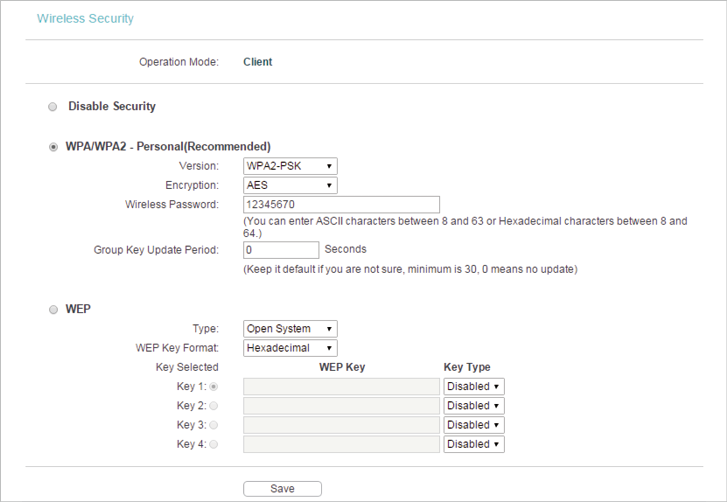
•Disable Security - Check this box radio button to disable wireless security. If disabled, the wireless stations will be able to connect this device without encryption. It is strongly recommended that you choose one of the security types to enable security.
•WPA/WPA2-Personal (Recommended) - Select WPA/WPA2 based on Radius Server.
•Version - You can select one of following versions.
•Automatic (Recommended) - Select WPA-Personal or WPA2-Personal automatically based on the wireless station’s capability and request.
•WPA-PSK - Pre-shared key of WPA.
•WPA2-PSK - Pre-shared key of WPA2.
•Encryption - You can select either Automatic(Recommended), TKIP or AES.
•Wireless password - You can enter ASCII or Hexadecimal characters. For Hexadecimal, the length should be between 8 and 64 characters; for ASCII, the length should be between 8 and 63 characters.
•Group Key Update Period - Specify the group key update interval in seconds. The value can be either 0 or at least 30. Enter 0 to disable the update.
•WEP - Select 802.11 WEP security.
•Type - You can select one of following types.
•Automatic - Select Shared Key or Open System authentication type automatically based on the wireless station’s capability and request.
•Shared Key - Select 802.11 Shared Key authentication type.
•Open System - Select 802.11 Open System authentication.
•WEP Key Format - You can select ASCII or Hexadecimal format. ASCII format stands for any combination of keyboard characters in the specified length. Hexadecimal format stands for any combination of hexadecimal digits (0-9, a-f, A-F) in the specified length.
•WEP Key - Select which of the four keys will be used and enter the matching WEP key information for your network in the selected key radio button. These values must be identical on all wireless stations in your network.
•Key Type - You can select the WEP key length (64-bit, or 128-bit, or 152-bit.) for encryption. “Disabled” means this WEP key entry is invalid.
•For 64-bit encryption - You can enter 10 hexadecimal digits (any combination of 0-9, a-f, A-F, zero key is not permitted) or 5 ASCII characters.
•For 128-bit encryption - You can enter 26 hexadecimal digits (any combination of 0-9, a-f, A-F, zero key is not permitted) or 13 ASCII characters.
•For 152-bit encryption - You can enter 32 hexadecimal digits (any combination of 0-9, a-f, A-F, zero key is not permitted) or 16 ASCII characters.
 Note:
Note:
• If you do not set the key, the wireless security function is still disabled even if you have selected Shared Key as Authentication Type.
Range Extender
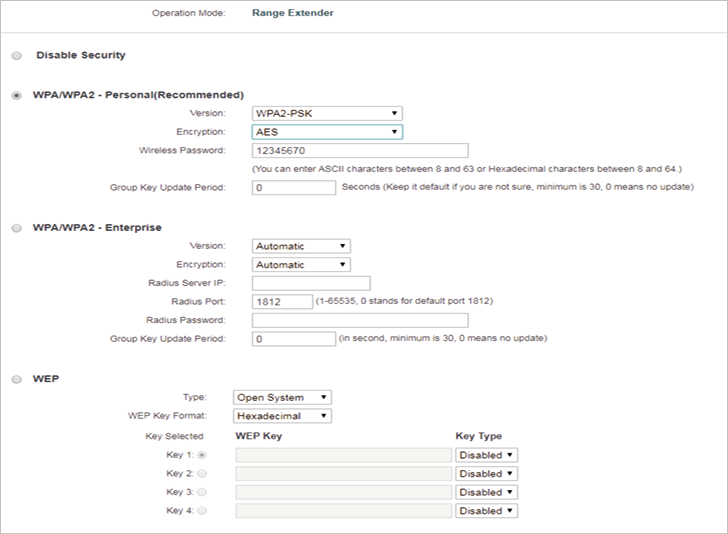
•Disable Security - Check this box radio button to disable wireless security. If disabled, the wireless stations will be able to connect this device without encryption. It is strongly recommended that you choose one of the security types to enable security.
•WPA/WPA2-Personal(Recommended) - Select WPA/WPA2 based on Radius Server.
•Version - You can select one of following versions.
•Automatic (Recommended) - Select WPA-Personal or WPA2-Personal automatically based on the wireless station’s capability and request.
•WPA-PSK - Pre-shared key of WPA.
•WPA2-PSK - Pre-shared key of WPA2.
•Encryption - You can select either Automatic(Recommended), TKIP or AES.
•Wireless password - You can enter ASCII or Hexadecimal characters. For Hexadecimal, the length should be between 8 and 64 characters; for ASCII, the length should be between 8 and 63 characters.
•Group Key Update Period - Specify the group key update interval in seconds. The value can be either 0 or at least 30. Enter 0 to disable the update.
•WPA/WPA2-Enterprise - Select WPA/WPA2 based on Radius Server.
•Version - You can select one of following versions.
•Automatic - Select WPA or WPA2 automatically based on the wireless station’s capability and request.
•WPA - Wi-Fi Protected Access.
•WPA2 - WPA version 2.
•Encryption - You can select either Automatic, TKIP or AES.
•Radius Server IP - Enter the IP address of the Radius Server.
•Radius Port - Enter the port used by radius service.
•Radius password - Enter the password for the Radius Server.
•Group Key Update Period - Specify the group key update interval in seconds. The value can be either 0 or at least 30. Enter 0 to disable the update.
•WEP - Select 802.11 WEP security.
•Type - You can select one of following types.
•Automatic - Select Shared Key or Open System authentication type automatically based on the wireless station’s capability and request.
•Shared Key - Select 802.11 Shared Key authentication type.
•Open System - Select 802.11 Open System authentication.
•WEP Key Format - You can select ASCII or Hexadecimal format. ASCII format stands for any combination of keyboard characters in the specified length. Hexadecimal format stands for any combination of hexadecimal digits (0-9, a-f, A-F) in the specified length.
•WEP Key - Select which of the four keys will be used and enter the matching WEP key information for your network in the selected key radio button. These values must be identical on all wireless stations in your network.
•Key Type - You can select the WEP key length (64-bit, or 128-bit, or 152-bit.) for encryption. “Disabled” means this WEP key entry is invalid.
•For 64-bit encryption - You can enter 10 hexadecimal digits (any combination of 0-9, a-f, A-F, zero key is not permitted) or 5 ASCII characters.
•For 128-bit encryption - You can enter 26 hexadecimal digits (any combination of 0-9, a-f, A-F, zero key is not permitted) or 13 ASCII characters.
•For 152-bit encryption - You can enter 32 hexadecimal digits (any combination of 0-9, a-f, A-F, zero key is not permitted) or 16 ASCII characters.
 Note:
Note:
•If you do not set the key, the wireless security function is still disabled even if you have selected Shared Key as Authentication Type.
WPS (Wi-Fi Protected Setup) can help you to quickly and securely connect to a network. This section will guide you to add a new wireless device to your access point’s network quickly via WPS.
 Note:
Note:
•The WPS function cannot be configured if the wireless function of the access point is disabled. Please make sure the wireless function is enabled before configuration.
•When working in Client mode, the WPS funcion of the access point is disabled.
1.Visit http://tplinkap.net, and log in using the password you created.
2.Go to WPS.
3.Follow one of the following three methods to connect your client device to the access point’s Wi-Fi network.
Method ONE: Press the WPS Button on Your Client Device
1.Keep the WPS Status as Enabled and click Add Device.
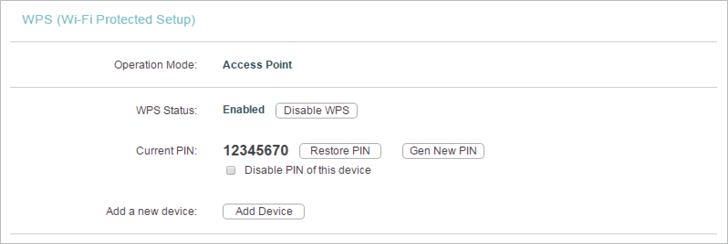
2.Select Press the button of the new device in two minutes and click Connect.

3.Within two minutes, press the WPS button on your client device.
4.A success message will appear on the WPS page if the client device has been successfully added to the access point’s network.
Method TWO: Enter the Client’s PIN
1.Keep the WPS Status as Enabled and click Add Device.

2.Select Enter the new device’s PIN, enter your client device’s current PIN in the PIN filed and click Connect.

3.A success message will appear on the WPS page if the client device has been successfully added to the access point’s network.
Method Three: Enter the Access Point’s PIN
1.Keep the WPS Status as Enabled and get the Current PIN of the access point.
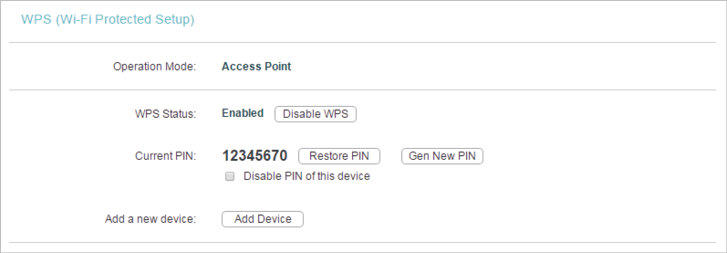
2.Enter the access point’s current PIN on your client device to join the access point’s Wi-Fi network.
4.4. Wireless MAC Filtering
Wireless MAC Filtering is used to deny or allow specific wireless client devices to access your network by their MAC addresses. This function is not available when the operation is set to Client. As the configuration is the same in each operation mode, here we just take the Access Point for example.
I want to:
Deny or allow specific wireless client devices to access my network by their MAC addresses.
For example, you want the wireless client A with the MAC address 00-0A-EB-B0-00-0B and the wireless client B with the MAC address 00-0A-EB-00-07-5F to access the access point, but other wireless clients cannot access the access point.
1.Visit http://tplinkap.net, and log in using the password you created.
2.Go to Wireless > Wireless MAC Filtering.
3.Click Enable to enable the Wireless MAC Filtering function.

4.Select Allow the stations specified by any enabled entries in the list to access as the filtering rule.
5.Delete all or disable all entries if there are any entries already.
6.Click Add New and fill in the blank.
1 )Enter the MAC address 00-0A-EB-B0-00-0B/00-0A-EB-00-07-5F in the MAC Address field.
2 )Enter wireless client A/B in the Description field.
3 )Select Enabled in the Status drop-down list.
4 )Click Save and click Back.
7.The configured filtering rules should be listed as the picture shows below.
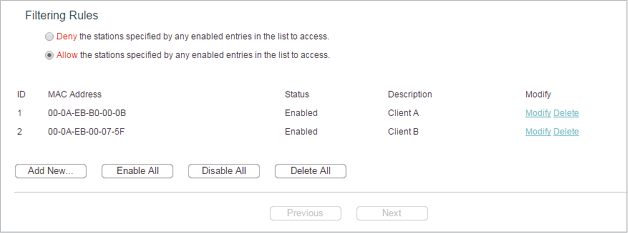
Done!
Now only client A and client B can access your network.
4.5. Wireless Advanced
The configuration for each operation mode is almost the same, we take Access Point mode for example here.
1.Visit http://tplinkap.net, and log in using the password you created.
2.Go to Wireless > Wireless Advanced.
3.Configure the advanced settings of your wireless network and click Save.
 Note:
Note:
If you are not familiar with the setting items on this page, it’s strongly recommended to keep the provided default values; otherwise it may result in lower wireless network performance.
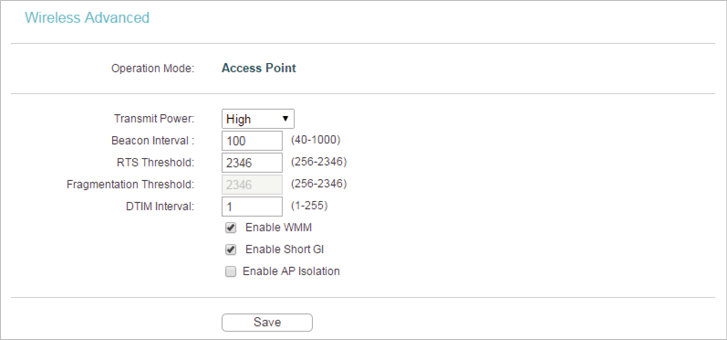
•Transmit Power - Select High, Middle or Low which you would like to specify for the access point. High is the default setting and recommended.
•Beacon Interval - Enter a value between 40-1000 milliseconds for Beacon Interval here. Beacon Interval value determines the time interval of the beacons. The beacons are the packets sent by the access point to synchronize a wireless network. The default value is 100.
•RTS Threshold - Here you can specify the RTS (Request to Send) Threshold. If the packet is larger than the specified RTS Threshold size, the access point will send RTS frames to a particular receiving station and negotiate the sending of a data frame. The default value is 2346.
•Fragmentation Threshold - This value is the maximum size determining whether packets will be fragmented. Setting a low value for the Fragmentation Threshold may result in poor network performance because of excessive packets. 2346 is the default setting and is recommended.
•DTIM Interval - This value determines the interval of the Delivery Traffic Indication Message (DTIM). A DTIM field is a countdown field informing clients of the next window for listening to broadcast and multicast messages. When the access point has buffered broadcast or multicast messages for associated clients, it sends the next DTIM with a DTIM Interval value. You can specify the value between 1-255 Beacon Intervals. The default value is 1, which indicates the DTIM Interval is the same as Beacon Interval.
•Enable WMM - WMM function can guarantee the packets with high-priority messages being transmitted preferentially. It is strongly recommended to enable this function.
•Enable Short GI - It is recommended to enable this function, for it will increase the data capacity by reducing the guard interval time.
•Enable AP Isolation - This function isolates all connected wireless stations so that wireless stations cannot access each other through WLAN. This function will be disabled if WDS/Bridge is enabled.
4.6. Wireless Statistics
The configuration for each operation mode is almost the same, we take Access Point mode for example here.
1.Visit http://tplinkap.net, and log in using the password you created.
2.Go to Wireless > Wireless Statistics to check the data packets sent and received by each client device connected to the access point.

•MAC Address - The MAC address of the connected wireless client.
•Current Status - The running status of the connected wireless client.
•Received Packets - Packets received by the wireless client.
•Sent Packets - Packets sent by the wireless client.
•Configure - The button is used for loading the item to the Wireless MAC Filtering list.
•Allow - If the Wireless MAC Filtering function is enabled, click this button to allow the client to access your network.
•Deny - If the Wireless MAC Filtering function is enabled, click this button to deny the client to access your network.
4.7. Throughput Monitor
1.Visit http://tplinkap.net, and log in using the password you created.
2.Go to Wireless > Throughput Monitor to view the wireless throughput information.
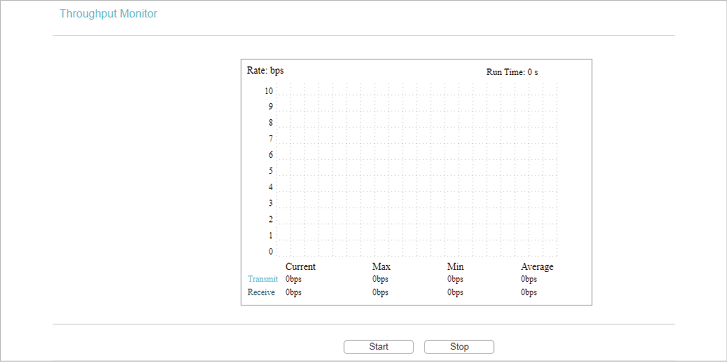
•Rate - The Throughput unit.
•Run Time - How long this function is running.
•Transmit - Wireless transmit rate information.
•Receive - Wireless receive rate information.
Click Start/Stop to start or stop wireless throughput monitor.
5.1. SNMP
Simple Network Management Protocol (SNMP) is a popular network monitoring and management protocol.
1.Visit http://tplinkap.net, and log in using the password you created.
1.Go to System Tools > SNMP.
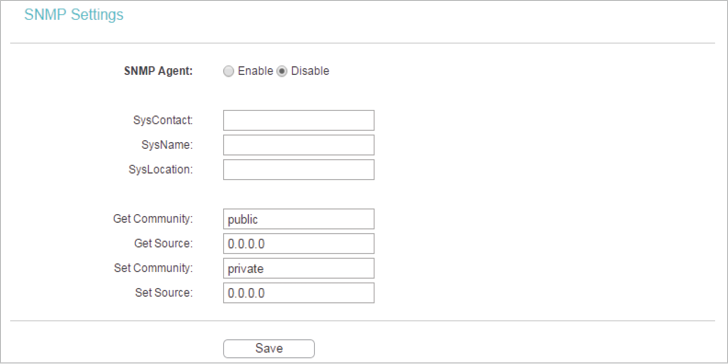
•SNMP Agent - Select the radio button before Enable will enable this function if you want to have remote control through SNMPv1/v2 agent with MIB-II. Select the radio button before Disable will disable this function. The default setting is Disable.
•SysContact - The textual identification of the contact person for this managed node.
•SysName - An administratively-assigned name for this managed node.
•SysLocation - The physical location of this node.
 Note:
Note:
If you are not familiar with the setting items on this page, it’s strongly recommended to keep the provided default values; otherwise it may result in lower wireless network performance.
•Get Community - Enter the community name that allows Read-Only access to the Device’s SNMP information. The community name can be considered a group password. The default setting is “public”.
•Get Source - Get source defines the IP address or subnet for management systems that can read information from this ‘get’ community device.
•Set Community - Enter the community name that allows Read/Write access to the Device’s SNMP information. The community name can be considered a group password. The default setting is “private”.
•Set Source - Set source defines the IP address or subnet for management systems that can control this ‘set’ community device.
 Note:
Note:
A restricted source can be a specific IP address (e.g. 10.10.10.1), or a subnet - represented as IP/BITS (e.g. 10.10.10.0/24). If an IP Address of 0.0.0.0 is specified, the agent will accept all requests under the corresponding community name.
5.2. Diagnostic
Diagnostic is used to test the connectivity between the access point and the host or other network devices.
1.Visit http://tplinkap.net, and log in using the password you created.
2.Go to System Tools > Diagnostic.
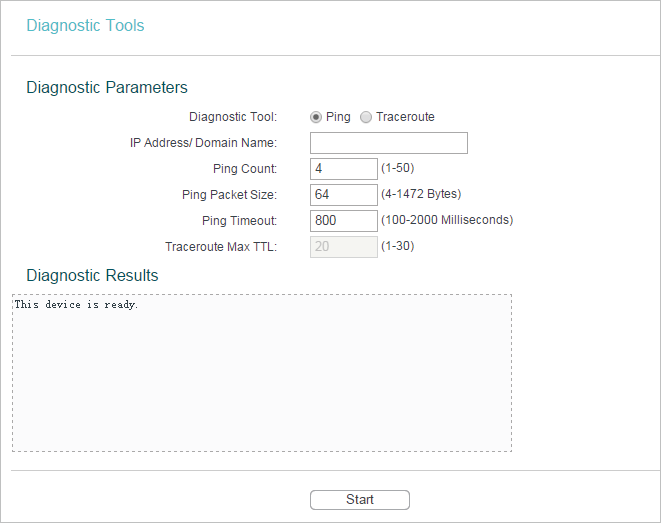
•Diagnostic Tool - Select one diagnostic tool.
•Ping - This diagnostic tool troubleshoots connectivity, reachability, and name resolution to a given host or gateway.
•Tracerouter - This diagnostic tool tests the performance of a connection.
 Note:
Note:
You can use ping/traceroute to test both numeric IP address or domain name. If pinging/tracerouting the IP address is successful, but pinging/tracerouting the domain name is not, you might have a name resolution problem. In this case, ensure that the domain name you are specifying can be resolved by using Domain Name System (DNS) queries.
•IP Address/Domain Name - Enter the destination IP address (such as 192.168.0.254) or Domain name (such as www.tp-link.com).
•Pings Count - The number of Ping packets for a Ping connection.
•Ping Packet Size - The size of Ping packet.
•Ping Timeout - Set the waiting time for the reply of each Ping packet. If there is no reply in the specified time, the connection is overtime.
•Traceroute Max TTL - The max number of hops for a Traceroute connection.
3.Click Start to check the connectivity of the Internet.
4.The Diagnostic Results page displays the diagnosis result. If the result is similar to the following figure, the connectivity of the Internet is fine.
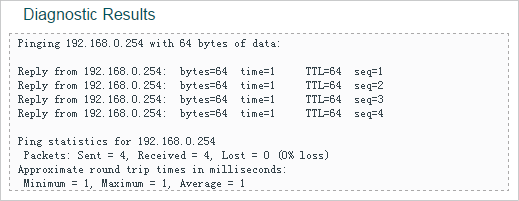
 Note:
Note:
Only one user can use this tool at one time. Options “Number of Pings”, “Ping Size” and “Ping Timeout” are used for the Ping function. Option “Tracert Hops” is used for the Tracert function.
5.3. Ping Watch Dog
The Ping Watch Dog is dedicated for continuous monitoring of the particular connection to remote host using the Ping tool. It makes the access point continuously ping a user defined IP address (it can be the Internet gateway for example). If it is unable to ping under the user defined constraints, the access point will automatically reboot.
1.Visit http://tplinkap.net, and log in using the password you created.
2.Go to System Tools > Ping Watch Dog. Configure the settings and click Save.
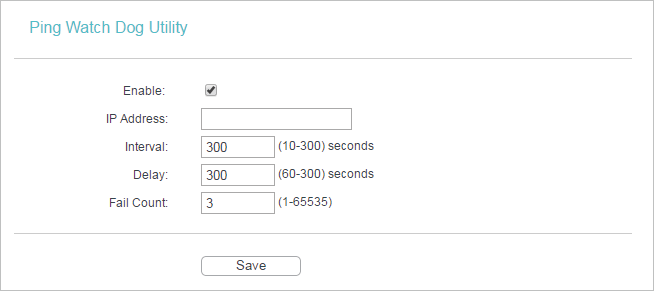
•Enable - Turn on/off Ping Watch Dog.
•IP Address - The IP address of the target host where the Ping Watch Dog Utility is sending ping packets.
•Interval - Time interval between two ping packets which are sent out continuously.
•Delay - Time delay before first ping packet is sent out when the access point is restarted.
•Fail Count - Upper limit of the ping packets the access point can drop continuously. If this value is overrun, the access point will restart automatically.
5.4. Firmware Upgrade
TP-Link is dedicated to improving and richening the product features, giving users a better network experience. We will release the latest firmware at TP-Link official website. You can download the latest firmware file from the Support page of our website
www.tp-link.com and upgrade the firmware to the latest version.
1.Download the latest firmware file for the access point from our website www.tp-link.com.
2.Visit http://tplinkap.net, and log in using the password you created.
3.Go to System Tools > Firmware Upgrade.
4.Click Choose File to locate the downloaded firmware file, and click Upgrade.

5.5. Factory Defaults
1.Visit http://tplinkap.net, and log in using the password you created.
2.Go to System Tools > Factory Defaults. Click Restore to reset all settings to the default values.

•The default IP Address: 192.168.0.254
•The default Subnet Mask: 255.255.255.0
5.6. Backup & Restore
The configuration settings are stored as a configuration file in the access point. You can backup the configuration file in your computer for future use and restore the access point to the previous settings from the backup file when needed.
1.Visit http://tplinkap.net, and log in using the password you created.
1.Go to System Tools > Backup & Restore.

•To backup configuration settings:
Click Backup to save a copy of the current settings in your local computer. A “.bin“ file of the current settings will be stored in your computer.
•To restore configuration settings:
1.Click Choose File to locate the backup configuration file stored in your computer, and click Restore.
2.Wait a few minutes for the restoring and rebooting.
 Note:
Note:
During the restoring process, do not power off or reset the access point.
5.7. Reboot
1.Visit http://tplinkap.net, and log in using the password you created.
2.Go to System Tools > Reboot, and you can restart your access point.

Some settings of the access point will take effect only after rebooting, including:
•Change the LAN IP Address (system will reboot automatically).
•Change the DHCP Settings.
•Change the Working Modes.
•Change the Web Management Port.
•Upgrade the firmware of the access point (system will reboot automatically).
•Restore the access point to its factory defaults (system will reboot automatically).
•Update the configuration with the file (system will reboot automatically).
5.8. Password
1.Visit http://tplinkap.net, and log in using the password you created.
2.Go to System Tools > Password, and you can change the old password you set for your access point.
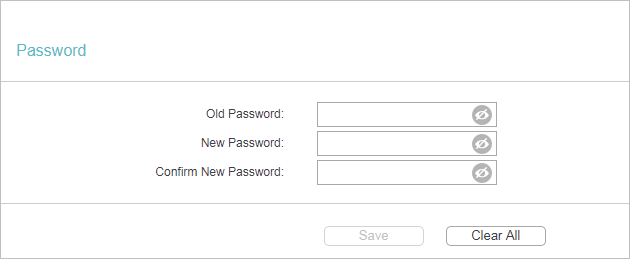
 Note:
Note:
The new password: must be 6-32 characters long;
must contain no space(s);
must contain at least two types of the following characters: letters, numbers and symbols.
3.Click Save.
5.9. System Log
1.Visit http://tplinkap.net, and log in using the password you created.
2.Go to System Tools > System Log, and you can view the logs of the access point.
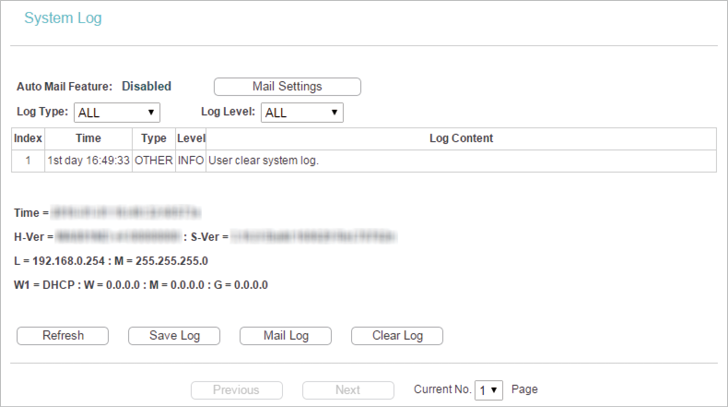
•Auto Mail Feature - Indicates whether the auto mail feature is enabled or not.
•Mail Settings - Set the receiving and sending mailbox address, server address, validation information as well as the timetable for Auto Mail Feature.
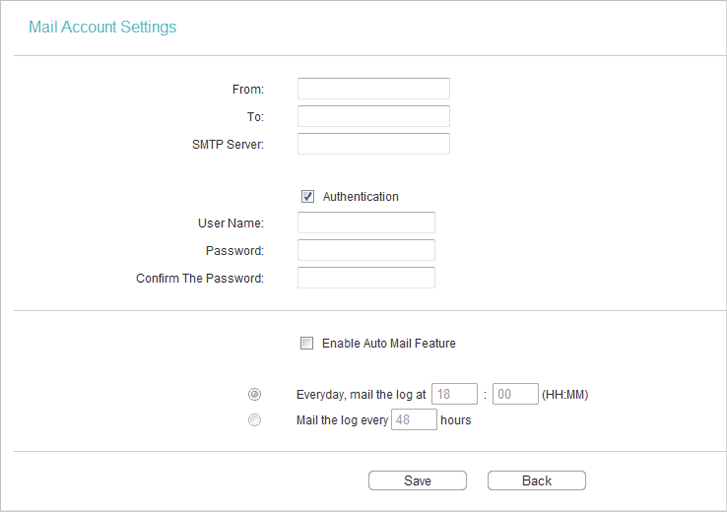
•From - Your mail box address. The access point will connect it to send logs.
•To - Recipient’s mail address. The destination mailbox which will receive logs.
•SMTP Server - Your smtp server. It corresponds with the mailbox filled in the From field. You can log on the relevant website for help if you are not clear with the address.
•Authentication - Most SMTP Server requires Authentication. It is required by most mailboxes that need user name and password to log in.
 Note:
Note:
Only when you select Authentication, do you have to enter the user name and password in the following fields.
•User Name - Your mail account name filled in the From field. The part behind @ is included.
•password - Your mail account password.
•Confirm The password - Enter the password again to confirm.
•Enable Auto Mail Feature - Select it to mail logs automatically. You could mail the current logs either at a specified time everyday or by intervals, but only one could be the current effective rule. Enter the desired time or intervals in the corresponding field.
Click Save to apply your settings.
Click Back to return to the previous page.
•Log Type - By selecting the log type, only logs of this type will be shown.
•Log Level - By selecting the log level, only logs of this level will be shown.
•Refresh - Refresh the page to show the latest log list.
•Save Log - Click to save all the logs in a txt file.
•Mail Log - Click to send an email of current logs manually according to the address and validation information set in Mail Settings.
•Clear Log - All the logs will be deleted from the access point permanently, not just from the page.
Click Next to go to the next page, or click Previous to return to the previous page.
Click Logout at the bottom of the main menu, and you will log out of the web page and return to the login window.